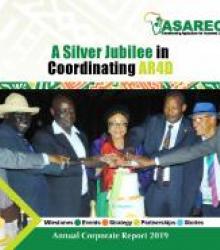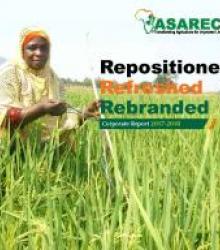| Title | Author | Asbract |
|---|---|---|
| Gender Mainstreaming to Support Agricultural Development for Improved Livelihoods Best Practices in Eastern and Southern Africa | Adeline R. Muheebwa, Yeshi Chiche | In December 2012, the programme on Sustainable Intensification of Maize-Legume cropping systems for food security in Eastern and Southern Africa (SIMLESA) commissioned a study to compile case studies of good practices in gender mainstreaming in the areas covered by the programme. This study was a result of an action point agreed on by participants at a Gender Mainstreaming Training Workshop held in July 2011 in Morogoro, Tanzania. The compilation of the case studies of good practices was intended to take stock and showcase the efforts of gender mainstreaming in the SIMLESA programme that had started three years earlier. The assignment had three major tasks: (1) to review the case studies collected by the SIMLESA programme staff to determine the potential for generation of gender responsive case studies; (2) to conduct field visits to the five countries (Ethiopia, Kenya, Malawi, Mozambique, Tanzania) and collect additional gender data/information on the case studies, to ensure that the case studies are comprehensive in demonstrating the gender concerns/issues from various countries; and (3) to compile at least five case studies for each country, highlighting the change resulting from (or impact of) the gender mainstreaming efforts of the SIMLESA programme. |
| End of Phase 1 EAAPP (East Africa Agriculture Productivity Programme) report | Kate Wellard, Tim Chancellor, Geresom Okecho, Sheba Ndagire and Stephen Mugarura | An ambitious regional programme, the Eastern Africa Agricultural Productivity Programme (EAAPP), which ASARECA has been coordinating for the last five years, has posted impressive impacts, prompting a call for immediate roll-out of a second phase. |
| Communication Strategy for sharing EAAPP innovations | ASARECA | Effective communication was critical to the attainment the objectives of the Eastern Africa Agricultural Productivity Program (EAAPP). For the commodity-based Centres of Excellence, to benefit the region, knowledge and information must be communicated and shared across national boundaries. This was basis on with the East African Agricultural Productivity Strategy and Implementation Plan was developed. The Communication Strategy contributes directly to the EAAPP purpose of enhancing regional communication and information sharing by EAAPP and the regional centres of excellence. |
| Eastern Africa Fall Armyworm Management Strategy and Implementation Plan | Brian Isabirye, Mathew Abang, Solomon Gelalcha and Winfred Hammond | The invasive fall armyworm (FAW), or Spodoptera frugiperda, is a pest ravaging crops in over 44 African countries. It is native to the Americas, but recently spread to Africa, with its occurrence first reported in West and Central Africa in early 2016. It spread to southern Africa in late 2016, and by early 2017 was confirmed in East Africa (FAO, 2017). FAW attacks more than 80 different plant species including maize, a major food staple in sub-Saharan Africa, upon which more than 300 million people depend. If FAW is not effectively controlled, it is expected to cause a US$3bn loss to maize in Africa along with serious food shortages in the next year (IAPPS, 2017). |
| Bye law development and implementation in Ethiopia | Willy Kakuru, Alex Muhweezi, Michael Waithaka, Miriam Kyotalimye, Joy Tukahirwa, Chilot Yirg | This manual outlines the process necessary for development and implementation of bye laws for Sustainable Land management (SLM). It is based on the experiences in SLM related rules and regulations formulation in different parts of Ethiopia. Lessons and experiences have also been drawn from the process used during formulation of the bye law for Dendi and Were Jarso districts. |
| Bye law development and implementation in Uganda | ASARECA | This manual outlines the process necessary for development and implementation of bye laws for Sustainable Land management (SLM). It is based on the experiences in SLM related rules and regulations formulation in different parts of Uganda. Lessons and experiences have also been drawn from the process used during formulation of the bye law for Benet Sub-county and Kabei Parish in Kapchorwa and Bukwo Districts respectively. |
| Commercialized Supply of Training and Certification in Milk Quality Assurance in Eastern Africa | P.Cherono, L. Kurwijila, A. Omore | This manual captures the basic experiences of dairy boards, nongovernmental organisations (NGOs) and smallÔÇÉscale milk market chain actors in East Africa in implementing a scheme on commercialised supply of training and certification (T&C) through business development services (BDS). This approach arose out of the need to fill the gap in delivery of services in milk quality assurance, in the face of continued dominance of informal raw milk markets that account for over 80% of marketed milk in the region, as a mechanism for addressing milk quality and safety concerns, improving market access and gradually bridging the gap between regulated and unregulated markets. Initially piloted in Kenya, where a major policy shift to allow raw milk sales by smallÔÇÉscale traders took place in 2004 with significant impacts on value chain actors preceded the engagements (Kaitibie et al., 2010), the approach has gained wider acceptance and is being outÔÇÉscaled in Kenya and piloted in Tanzania and Uganda |
| Njia Bora za Ukusanyaji na Upimaji Maziwa (Milk Hygiene(Module 2) | Isha Muzira, Michel Ngarambe, Obed Ndankuu, Philip K Cherono | Maziwa yanayokamuliwa kutoka kwenye ngombe mwenye afya yanakuwa na bakteria wachache sana. Uchafu unaingiza bakteria wanaosababisha maziwa kuharibika haraka. Ili kuhakikisha maziwa yanaendelea kuwa freshi kwa muda mrefu zaidi unahitaji usafi wa ukamuaji na utunzaji wa maziwa. |
| SEED CERTIFICATION STANDARDS FOR TEN SELECTED CROPS OF MAJOR ECONOMIC IMPORTANCE IN EAST AFRICA. | Obongo Nyachae | The process of harmonization and rationalization of seed policies and regulations started as a pilot phase for East African countries in 1999. It soon encompassed other countries, who joined as second phase, while others joined the process later as third phase. |
| Usindikaji Bora wa Maziwa (Milk Hygiene(Module 5) | Isha Muzira, Michel Ngarambe, Obed Ndankuu, Philip K Cherono, | [SWAHILI] Ni muhimu kwa msindikaji kuelewa kuwa maziwa yasipohudumiwa katika hali ya usafi kuanzia kwa mfugaji, ubora wake hauwezi ukarekebishwa na yatakuwa hayafai kwa usindikaji. Kwa kuzingatia hayo, kipengele hiki cha uzalishaji bora wa maziwa kimeingizwa kwenye mwongozo huu ili kukusaidia kuelewa mambo yanayoathiri ubora wa maziwa kwa kuangalia mfumo mzima kuanzia ngazi ya mfugaji mpaka kumfikia msindikaji. |
| Utunzaji, Uhifadhi na Usafirishaji Bora wa Maziwa (Milk Hygiene(Module 3) | Isha Muzira, Michel Ngarambe, Obed Ndankuu, Philip K Cherono | [SWAHILI] Maziwa yanayokamuliwa kutoka kwenye ngombe mwenye afya yanakuwa na bakteria wachache sana. Uchafu unaingiza bakteria wanaosababisha maziwa kuharibika haraka. Ili kuhakikisha maziwa yanaendelea kuwa freshi kwa muda mrefu zaidi unahitaji usafi wa ukamuaji na utunzaji wa maziwa. |
| Uzalishaji Bora wa Maziwa (Milk Hygiene Module 1) | Isha Muzira, Michel Ngarambe, Obed Ndankuu, Philip K Cherono | [SWAHILI] Maziwa yanayokamuliwa kutoka kwenye ngombe mwenye afya yanakuwa na bakteria wachache sana. Uchafu unaingiza bakteria wanaosababisha maziwa kuharibika haraka. Ili kuhakikisha maziwa yanaendelea kuwa freshi kwa muda mrefu zaidi unahitaji usafi wa ukamuaji na utunzaji wa maziwan |
| Tissue culture, conservation biotechnology, virus indexing and seed systems of vegetative crops: A training manual | ASARECA | The compilation of this manual arises from the fact that knowledge on tissue culture, conservation biotechnology, virus indexing and seed systems for vegetative crops (in this case cassava and sweet potato) and associated techniques, are scattered and not readily available for use by practitioners or would-be-practitioners. This manual is a response to this gap and thus presents principles and practices of tissue culture, conservation biotechnology, virus indexing and seed systems. The manual will be used by research scientists and technicians working in tissue culture, conservation biotechnology, virus indexing and seed systems for vegetative crops. The manual could also be useful to students and lectures undertaking these modules as part of the curriculum at colleges or universities. To my knowledge, this is the first compilation on these diverse topics that are tailored to vegetative crops. Thus, this is both an opportunity and a challenge. It is our sincere hope that later issues will cover more case studies and future advances in these fields. Users are encouraged to adapt the references to their own working conditions and to add more materials as they deem fit. |
| Quality Protein Maize Production and Post Harvest Handling Handbook for East and Central Africa | ASARECA | This manual is a comprehensive one-stop source of information on how Quality Protein Maize (QPM) is grown using recommended practices to achieve genetic potential of the varieties. It also contains management options for economically important diseases and insect pests, post harvest handling and utilization. The practices documented in this manual are based on practical experience of researchers in the region who worked with farmers to identify common problems in production of QPM and to validate the improved practices presented in it. These can be applied to other types of maize and areas within the region that broadly fall within the same mega-maize environment. |
| Chemical composition and nutritional values of feed resources for ruminants | Germana H. Laswai, Dyness M. Mgheni, Louis A. Mtenga, Jean Ndikumana, Emmanuel Zziwa | This Feed Table, which is generated from the feed resources data base established through the implementation of the project on ÔÇ£Establishment of feed resources data base in Eastern and Central AfricaÔÇØ implemented in Burundi, Kenya, Rwanda, Tanzania and Uganda from January 2010 to December 2011. The feed table summarizes available information on chemical composition, digestibility and energy values of locally available feed-stuff resources in the region. Perusing through this Feed Table, it is clear that there are some gaps and these calls for further research by National Agricultural Research Systems (NARS) in the region to fill the gaps. However, this Feed Table acts as a guide to proper feeding of animals and is therefore very useful to livestock advisors and progressive farmers. Furthermore, the Feed Table will provide quick access to information on feedstuffs to researchers and students in agriculture, animal science, veterinary and allied sciences. Feed manufacturers and policy makers will also benefit from the information in this Feed Table. It is hoped that farmers will be given training on how to use the Feed Table to enable them understand available feed resources and their quality, planting or purchasing of quality feedstuffs and of required standards. In addition, the farmers will be able to make proper feed formulation and feeding strategies for various classes of animals at different production stages. For effective use of this Feed Table, livestock advisors, feed manufacturers and farmers must be taught on how to make use of such data for day to day decision making on feeding livestock economically for increased livestock products of good quality and hence optimise profitability of livestock enterprises |
Search
Search entail eLibrary collection
Copyright © 2025. All rights reserved.
Designed By ASARECA


